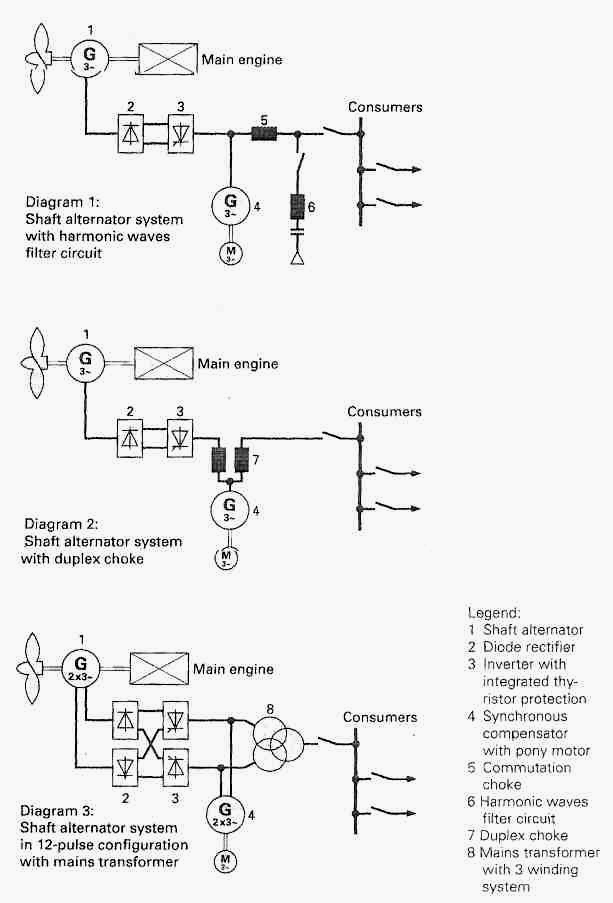
- •1Sp 2 semester Module 1
- •1.1. Shaft Alternators on Board Ships
- •Operating Principle
- •Advantages of the shaft alternator systems
- •Improved availability thanks to fully digitalized control and monitoring system
- •Closed-loop control
- •Advantages of the shaft alternator systems of stn systemtechnik nord
- •2000 KW, 840-1400 rpm shaft alternator on the polar research vessel „Polarstern", driven via the power take-off of a reduction gear
- •1.2. Turbogenerator
- •2.1. Boiler design
- •2.2. Refplant cycle of operation
- •Words to be Learnt
- •2.3. Air compressor
- •1. Personal safety
- •2. About the compressor
- •2.1 Construction
- •2.2 Safety equipment
- •Important: The safety valves, bursting disc and any other safety equipment must be inspected regularly.
- •3. Installation and operation
- •3.1 Installation instructions
- •3.2 Cooling water system
- •3.3 Start-up
- •3.4 Operation
- •3.5 Stopping
- •4. Operational failures
- •5. Inspection and maintenance
- •5.3 Lubrication system
- •5.4 Bearings
- •5.5 Pistons and piston rings
- •5.7 Coolers
- •5.8 Filters
- •2.3. Special purpose plants and machines
- •Tachogenerator Interface Board
- •Ac Drives
- •Transmitter - receiver
- •Differential transmitter - receiver
- •Control transformer
- •Resolver
- •General Description
1Sp 2 semester Module 1
UNIT 1. POWER PLANTS
1.1. Shaft Alternators on Board Ships
Shaft alternators on board ships are alternators driven by the main engine to supply power to the mains. The power generation has to function properly also at changing speeds of the propulsion shaft, that is when the vessel travels at different speed ranges. This basic requirement applies to vessels with fixed pitch propellers as well as to vessels with controllable pitch propellers where, for reason of propeller efficiency optimization, both engine speed and propeller pitch are changed. Thus shaft alternator operation is also possible during manoeuvring of the vessel (operation of shaft alternator from pier to pier) with feeding of big consumers as e.g. thrusters. This results in smaller diesel generator sets.
It is a generally accepted principle to design the system in such a way that full alternator capacity is avail able at speeds between 60% and 100% of the rated speed. Apart from the relatively slow engine speed changes from one manoeuvring step to another, the system has to work properly and keep voltage and frequency constant even in case of very fast speed changes caused by heavy seas.
The use of shaft alternator systems is an especially economical solution. For this reason more and more vessels are equipped with these systems. There are many reasons to use shaft alternator systems:
Lowering of fuel costs by lower heavy diesel oil cost and better efficiency of main engine
Reduction of maintenance and lubricant cost by reduction of operating time of auxiliary generating sets
Saving of operating personnel by simplification of ship machinery operation, as the mains is fed only by the shaft alternator system
Low noise level in the engine Room
Smaller diesel generator sets for operation during manoeuvring of the vessel and in harbour condition only.
Operating Principle
The main components of the shaft alternator systems are shown in the schematic diagrams.
The active power of variable frequency generated by the synchronous shaft alternator (1) is fed via diode rectifier (2), mains-controlled inverter (3) and commutation choke (5) respectively duplex choke (7) or mains transformer (8) to the mains. The rectifier (2) is mounted on top of the shaft alternator (1) in a space saving manner. The frequency is kept constant automatically by means of the excitation of the shaft alternator (1) by adaptation of the active power output of the inverter (3) to the respective consumer in the mains. The high speed thyristor protection system, integrated in the inverter (3), protects the inverter fuses even at extreme faults such as short circuit in the mains.
The synchronous compensator (4) controls the voltage by means of the built-in automatic voltage regulator and supplies the required reactive power for the mains and the inverter (3) as well as the short circuit current necessary for the selectivity during short circuits.
The harmonics generated by the inverter (3) have to be reduced to admissible levels according to the rules of classification societies.
Depending on the load and on the system data the shaft alternator system is configured according to the schematic diagrams with:
Harmonic waves filter circuit (6),
Duplex choke (7),
Main transformer with 3 winding system in 12-pulse connection (8).
|
|
|
|
| |



